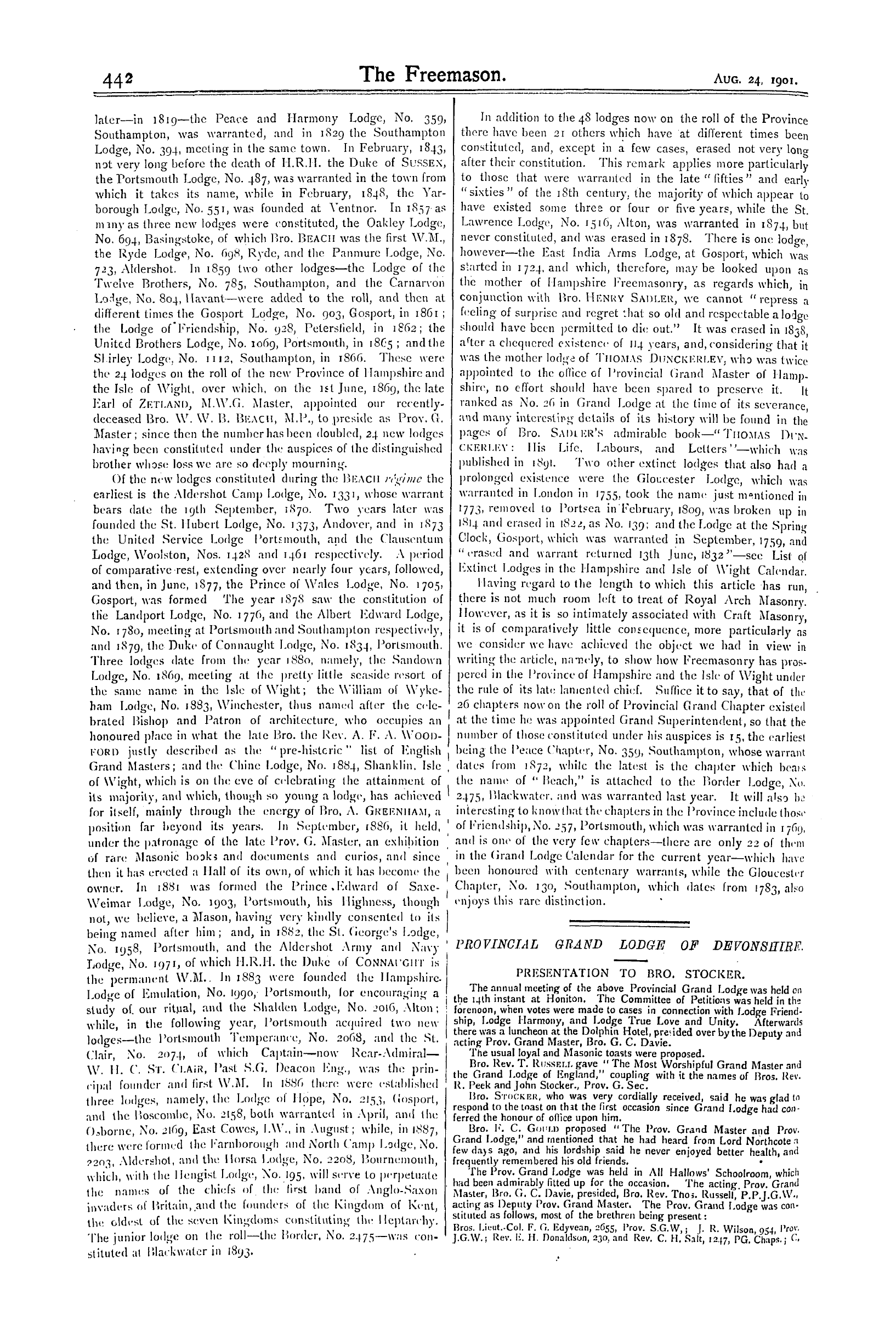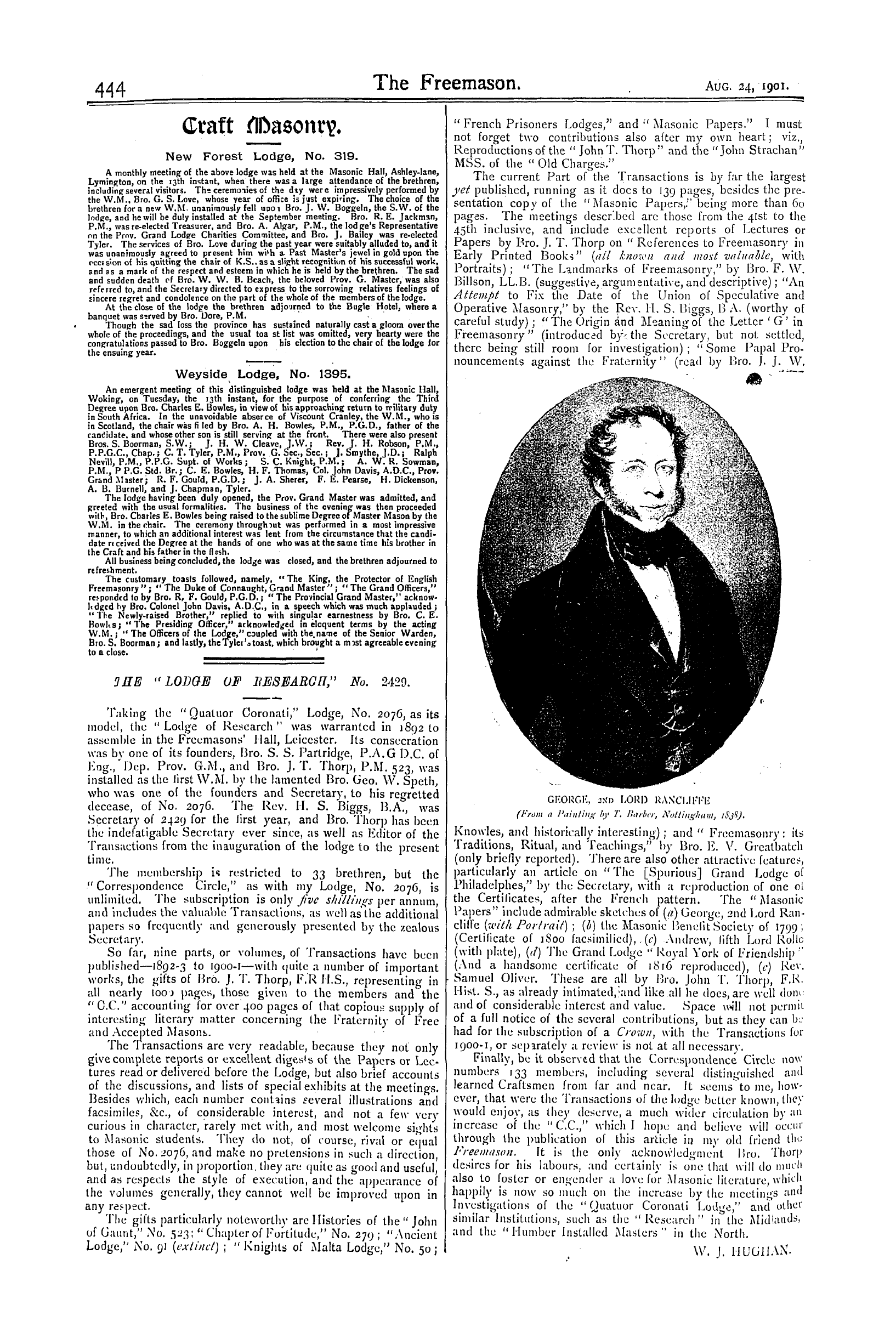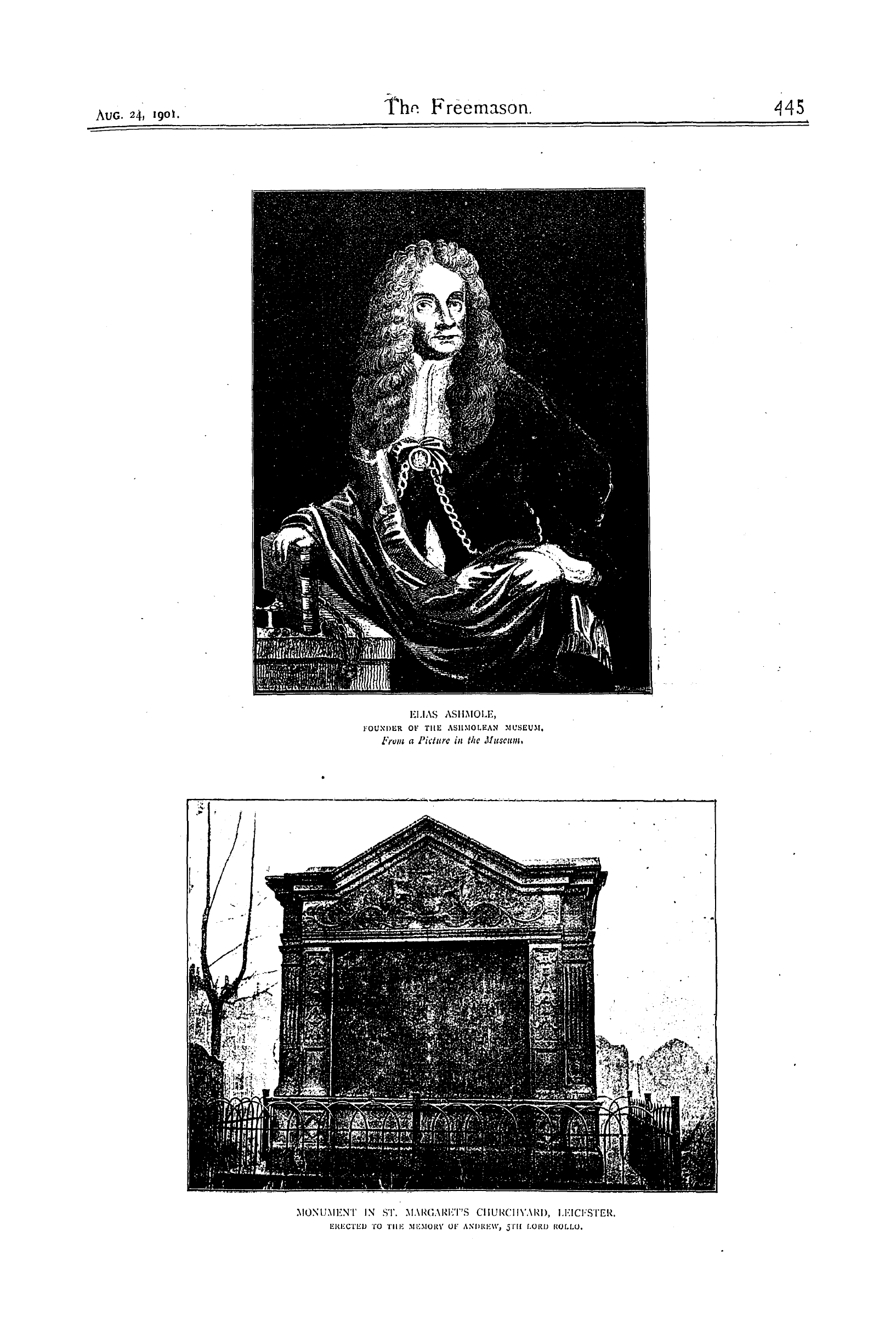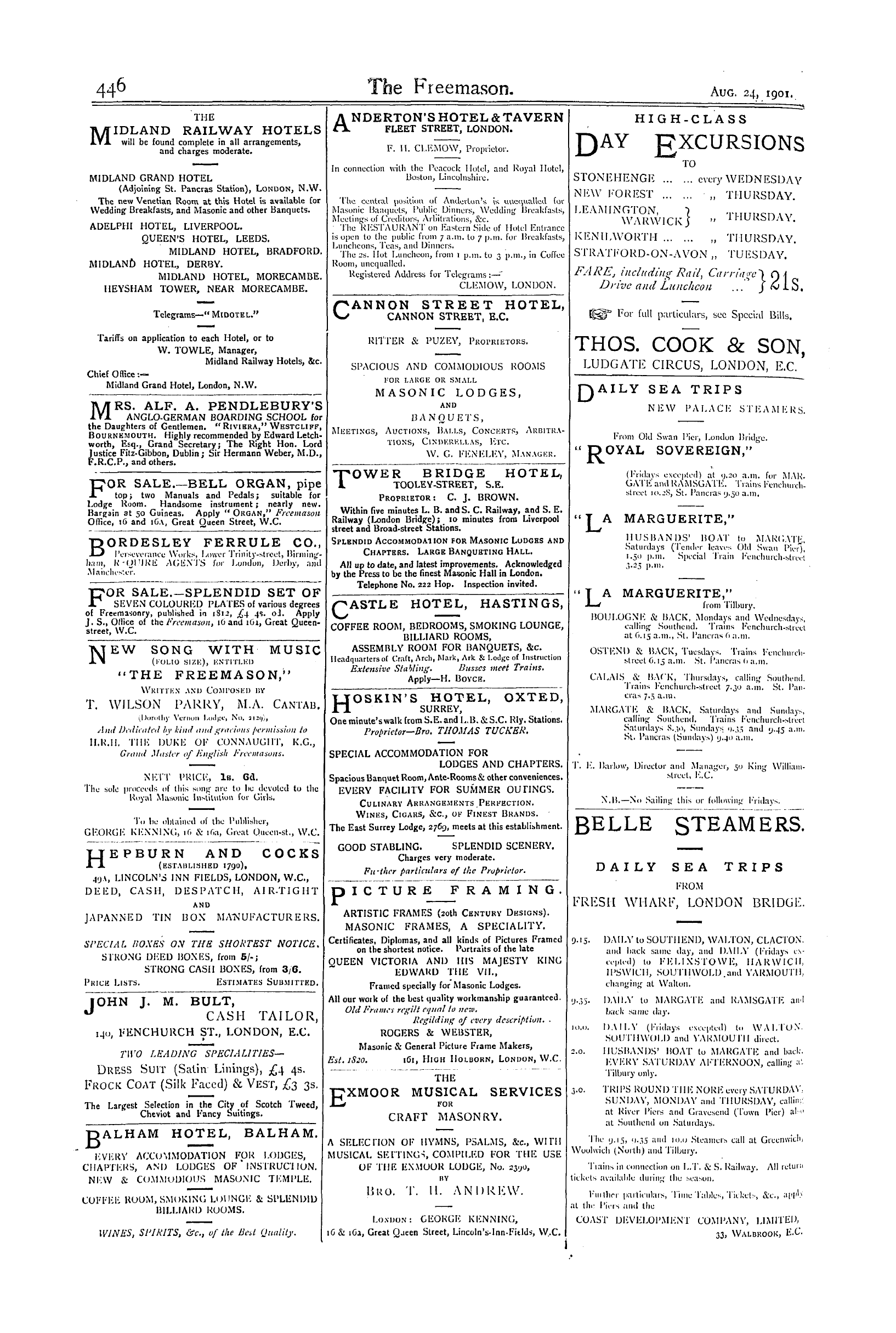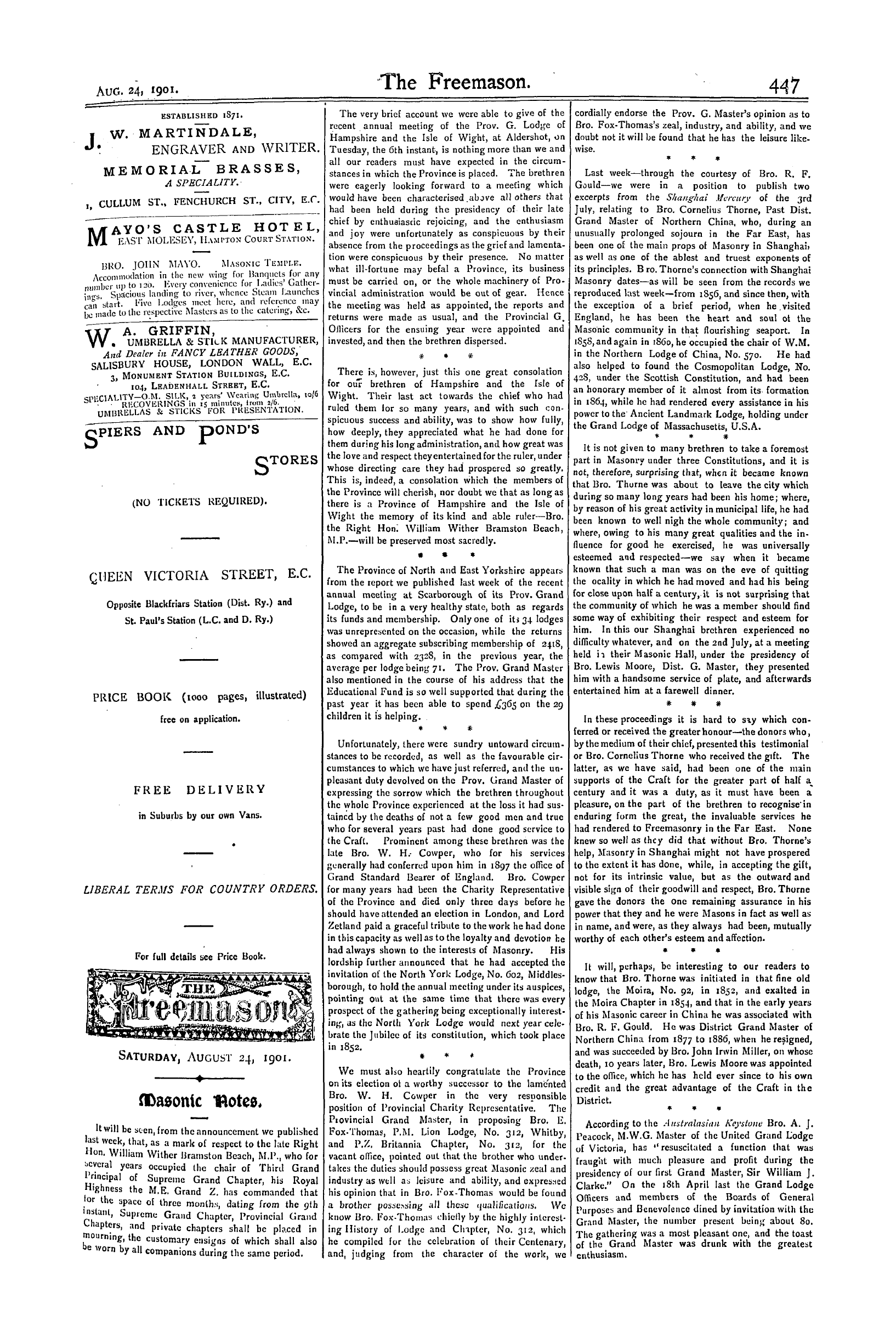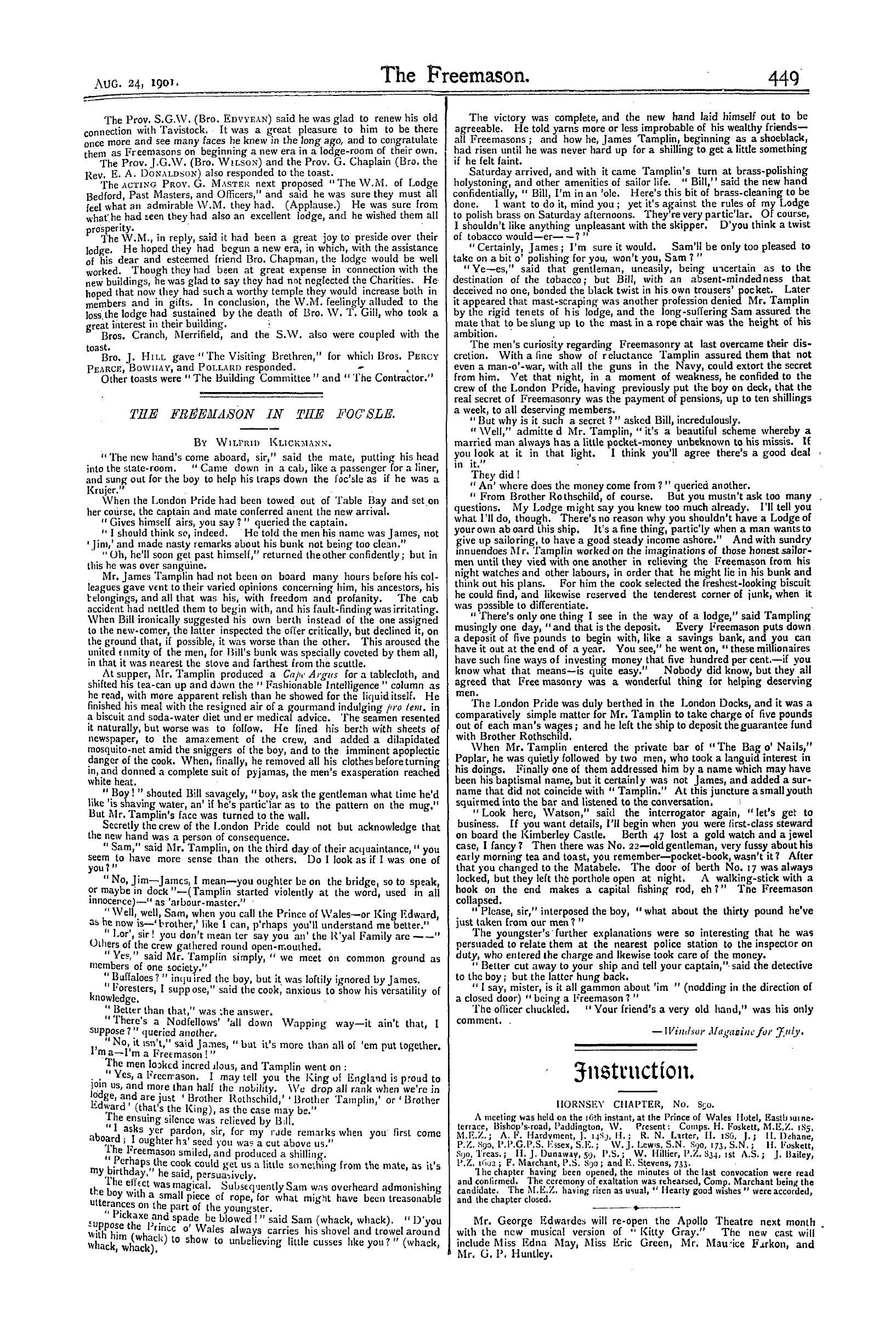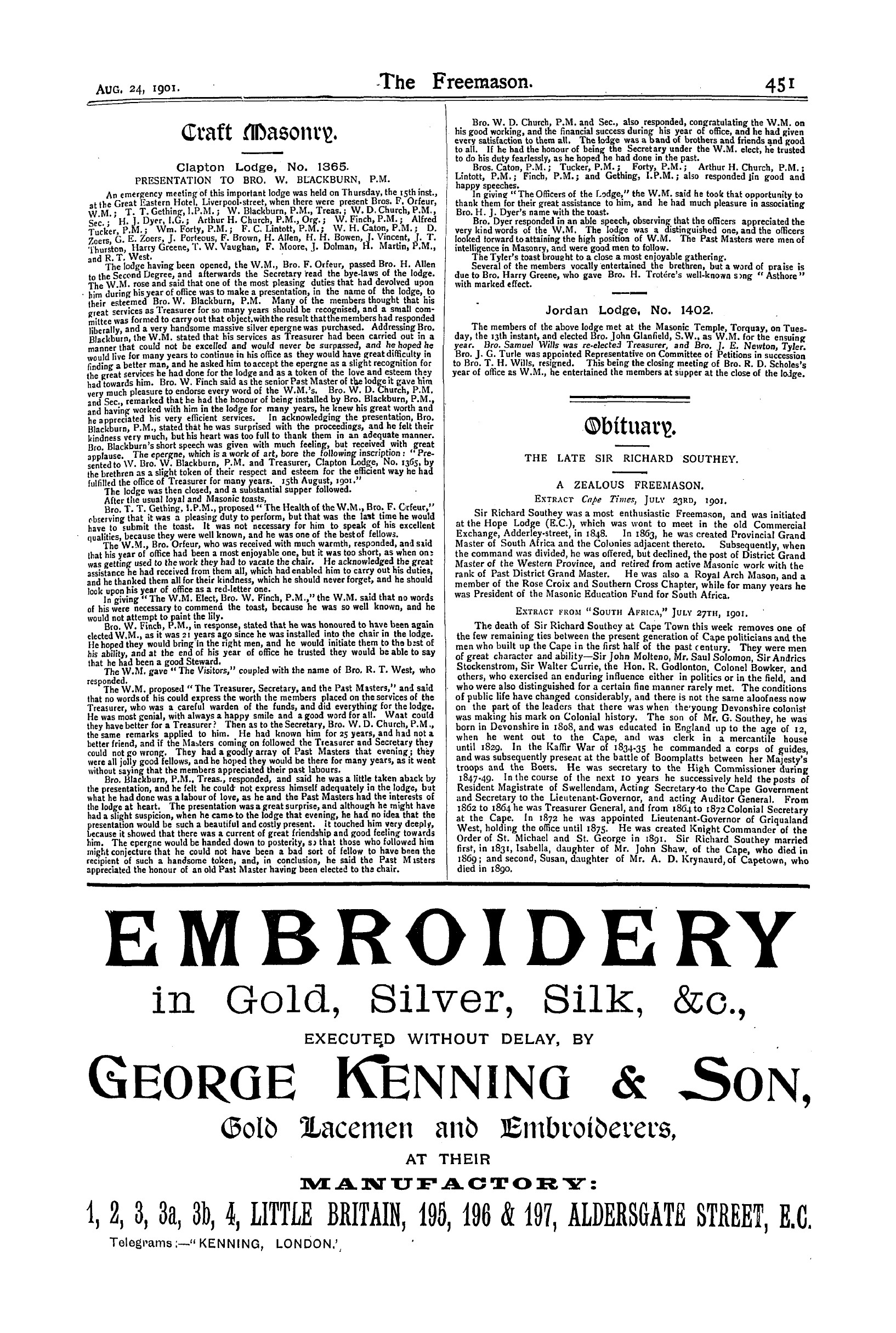-
Articles/Ads
Article Science, Art, and the Drama. Page 1 of 1 Article Science, Art, and the Drama. Page 1 of 1 Ad Untitled Page 1 of 1
Note: This text has been automatically extracted via Optical Character Recognition (OCR) software.
Science, Art, And The Drama.
Science , Art , and the Drama .
INSECTS USED AS FOOD BY MAN . The Crustacea , or Crab genus , largely used as food is universally reckoned amongst our greatest dainties ; and they who would turn with disgust from a locust or the grub of a beetle , feel no symptoms of nausea when a lobster , crab , or shrimp is set before them . The fact is that habit has reconciled us to the eating of these last , which , viewed in themselves , with their threatening claws and many feet , are really more disgusting than the
former . Had the habit been reversed , we should have viewed the former with appetite and the latter with abhorrence as do the Arabs " who are as much astonished at our eating crabs , lobsters , and oysters , as we are at their eating locusts . " If we lay aside our English prejudices , we shall find that insects used as food , generally speaking , live on vegetable substances , and are consequently much more select and cleanly in their diet than the
swine or the duck , which form a favourite part of ours . Many Iarv . c that belong to the ordtr Coleoptera are eaten in different parts of the world . The grub of the palm weevil , which is the size of the thumb , has been long in request in both the Indies . CEIian speaks of an Indian king , who , for dessert , instead of fruit , set before his Grecian guests a roasted worm taken from a plant , probably the larva of this insect , which he says the Indians
esteem very delicious—a character that was confirmed by some of the Greeks who tasted it . Madame Merian says that the natives of Surinam roast and eat them as something very exquisite . A long resident in the West Indies , where the palm grub is called Grugrii , relates that the late Sir John La Forey , who was somewhat of an epicure , was extremely fond of it when properly cooked . The larv . u also of the larger species of the
Capricorn tribe are accounted very great delicacies in many countries and the Cossus of Pliny , which he tells us the Roman epicures fattened with flour , most probably belonged to this tribe . Another grub which is the thickness of a man ' s finger , is eaten at Turman , in America , and in the West Indies , both by whites and blacks , who empty , wash , and roast them , and find them delicious . In Jamaica this grub is called Macaneo ,
and is in request at the principal tables . A similar insect is dressed at Mauritius under the name of Montac , which the whites as well as negroes cat greedily . It is probable that all the species of this genus might be safely eaten , as well as many other grubs of Coleoptera , as also the larv-i * of the cockchafer , which feed upon the roots of grass , and even the perfect insects themselves , which , if we may judge from the eagerness with which cats and
turkeys and other birds devour them , are no despicable bonne bottchc , and might be added to our entremets . This would be one means of keeping down the numbers of these occasionally destructive animals . The Mexican Indians , according to M . Vasselet and Madame Sallu and her son , who have transmitted such numbers cf fine insects from Mexico to Paris , prepare a liquor from a beetle by macerating it in water or spirit , which they
apparently use as a stimulating beverage . In the next order of insects , the Orthoptera , the Gryllus , or locust tribe , as they are the greatest destroyers of food , so as some recompense they furnish a considerable supply of it to numerous nations . They are recorded to have done this from the most remote antiquity , some Ethiopian tribes having been named from this circumstance— Acridophazi ( locust-eaters ) . Pliny also relates that they were
in high esteem as meat amongst the Parthians . Hasselgist , in reply to some inquiries which he made on this subject with respect to the Arabs , was informed that at Mecca , when there was a scarcity of corn , as a substitute for flour , they would grind locusts in their hand-mills , or pound ihem on stone mortars , that they mixed this flour with water into a dough , and made their cakes of itwhich
, they baked like their other bread . He adds that it is not unusual for them to eat locusts when there is no famine ; but then they boil them first a good while in water , and afterwards stew them with butter into a kind of fricassee of no bad flavour . Leo Africanus , as quoted by Bochart , gives a similar account . Sparrman informs us that the Hottentots are highly rejoiced at the arrival of Ihe locusts
in their country , although they destroy all its verdure , eating them in such quantities as to get visibly fatter than before , and making of their eggs a brown or coffee-coloured soup . He also relates a curious notion which they have with respect to the origin of the locusts—that they proceed from the goodwill of a great master conjuror a long way to the north , who , having removed the stone from the mouth of a
certain deep pit , lets loose these animals to bc food for them . This is not unlike the account given by the author of the Apocalypse of the ori gin of the symbolical locusts , which are said to ascend upon an angel ' s opening the pit of the abyss . Clenard , in his letters quoted by Bochart , says that they bring waggon-loads of locusts to Fez as a usual article of food . Major Moor states that when ihe cloud of locusts visited the Mahratta country the common people salted and ate them . This was anciently the custom with
many of the African nations , some of whom also smoked them . They even appear lo have been an article of food offered for sale in the markets of Greece ; and on a subject so well known , to quote no other writers , Jackson observes that , when he was in Barbary in 179-j , dishes of locusts were generally served at the principal tables , and esteemed a great delicacy . 'I hey are preferred by the Moors to pi geons ; and a person may eat a plateful of two or three hundred without feeling any ill effects . They usuallboil them in water half hour
y an ( having thrown away the head , wings , and legs ) , then sprinkle them with salt and pepper , and fry them , ' adding a little vinegar . From this string of authorities we readily see how idle was the controversy concerning the locusts , which formed part of the sustenance of John the Baptist , agreeing with Hasselquist , that they could be nothing but the animal locust , so common a food in the East ; and how apt ever learned men are to perplex a plain question from ignorance of the customs of other countries . ( To be continued . )
THE MEDALLIST BRIOT .
( Continued ] . To all , or to almost all his coins and medals , Briot put at least thc initial of his name . He was employed both in England and Scotland . In 16 31 , as appears by Rymer ' s I'V-dera , a special commission was appointed for making trial of the experience , skill , and industry of Nicholas Briot , in thc coinage of money at the mint , dated 13 th June , 1631 , at Westminster . This was the project he had attempted in France , by instruments , mills , and presses , to make better money and with less expense to the Crown than by
Science, Art, And The Drama.
way of hammering . The scheme was probably approved , for in the very next year we find him coining money upon the regular establishment . There is extant a parchment roll containing the accounts of Sir Robert Harley , Knight of the Bath , master worker of his Majesty ' s monies of gold and silver within the Tower of London , in the reign of King Charles I ., from S * . h November , 1628 , to ist August ,
1636 . In this account , in 1632 , are payments to Btiot for coining various parcels of gold and silver , which are followed by this entry : "And delivered to his Majestie in fair silver monies at Oatlands , by Sir Thomas Aylesbury , viz ., 111 crownes , and in half crownes , of Briot's moneys , and in crownes , and n 1 half crownes , and ten shillings of the monoyers making . " These comparative pieces were probably presented to
the King by Sir Robert Harley , Briot ' s patron , to show the superior excellence of the latter ' s method . The coronation medal of Charles I ., when he underwent his inauguration at Edinburgh , iSth June , 1633 , was executed by Briot . It was the first piece struck in Britain with a legend on the edge ; and was , as is supposed , the only one ever coined in gold found in Scstland . On the front is the King ' s bust , crowned and robed , with his titles . The
reverse bears a thistle growing , " Hine nostra : crevere ros-x . Around the edge is " Ex auro ut in Scotia reperitur Briot fecit Edinburgh 1633 . " Three on ' y of them are known to exist , one of which is in the British Museum Briot returned to France about 1642 , having formed that excellent scholar Thomas Simon . In a private family , it is said , there is a peach stone on which is carved the head of King Charles , full faced , with a laurel , and on the reverse St . George on horseback , with the garter round it ; and
on one side above the King ' s head , these letters N B . The tradition in that family was that the carver having been removed from the service of the crown , and at last obtaining the pUce of poor knight at Windsor , cut that curiosity to show he was not superannuated , or incapable of his office , as he had been represented . The story is rather doubtful , or Briot did not return to France on the breaking out of the Civil War—the latter is most likely . In the museum at Oxford , are two small carvings in wood—Christ on the Cross , and the Nativity , with the same cypher N B on each ' .
THE LIONS IN TRAFALGAR-SQUARE . We have , of late , been so accustomed to hoardings that the boxed-up lion on the north-west corner of Trafalgar-square has excited butlittle attention . The truth is they are scraping and cleaning his leonine majesty , and presently his three companions will have to undergo a similar operation . The four lions are the work of Sir Edwin Landsesr ; the three were designed from one model , and the casting cost , £ 16 , 000 . Landseer
drew his designs for the modelling in charcoal , on the walls of the studio , which he used specially for the purpose . He was not a man to make a fuss about his work , but it was a costly Vandalism that white-washed the drawings away . They might have been copied or photographed ; they would have been valuable examples of the artist ' s draughtsmanship . Talking of hoardings , there is , of course , no room for the bill-sticking
operations on the small one round the lion , and had there been , gne would have protested against Trafalgar-square being made a posting station . The vast hoarding in the Strand that covers the wreckage and rebuilding of houses in connection with the Strand and Holborn improvements is quite an artistic arrangement of well-designed placards , and the rent of it for this purpose , paid by the agents to the Cojnty Council , is saiu to be upwards of ^ 3030 per annum .
GENERAL NOTES . At the Adelphi Theatre not even the name will remain when the new playhouse erected upon its site , to be called " The Century , " is opened . Few persons , probably , are aware that thi Adelphi was so called after th * i three brothers Adam , the famous architects of 120 years ago , to whom wc owe the adjacent Exeter Hall , the Adelphi-terrace , and Stratford-place ,
Oxford-street , besides many country houses throughout the length and breadth ol the land , characterised by similar exquisite purity of semi-classic design . For the playgoer the disappearing dramatic homa of "The Harbour Lights" and many another illusive melodrama will b 2 linked memorably with the tragic death of their favourite stage hero—the sjrelymissed and long-lamented William Terriss .
Ad01002
V . JkX OBTAINABLE <¦<¦ /__ ¥ * C 3 Yi . _ . . » »*" \<$>XON pa§m\m \ Ai \ WKLL-KNOWN PLAN OP t^oiXRc^OMONTHLY •cases'••fflSQtVpAYMMTS I > OK 9 ^^ \ * Ci \ CATALOGUE MSS^NV<\CASH PR ,CES ' jT ^ X X . " * - * 'V ^* **> N . / X . _ ^& l w \ . ¦ itnsli-atcd I ' ntnloiiuoot /' . * ' " \ N ^ C ^ fc X Winches , ' 'locks /' . '* <^ E » T ~ j * x \ \ ' ^ f > _ , X Jewellery , & c , a "' l / / 4 V ^^^? A 1 Tn X ATm »\ " 'i ' i " T' « i ; s " I * * -f-iVa ^ Vv ^ , 1 X AV 0-+ \ ^«» " f trLM' ^ G M | Silver , X *^ 3 S ^ X 1-- ''^' I*^§IJblO\f>Nv \ G ^^ -i . m NT f \ X . V -W Tli " * l * ll'l . ir *\ v , ! . ! ii . \ ¦ ? > \ - , m i , ' . ! i . i ., ii * iM .- ' . * iii . i * . i '" i'i"i X ^ # ^ -. \ - mW ¦ Iiii | . r . n ,. in ,. | , l . Ili . t Ii > ' il X -t ^ . Af X- --s ^ r -- > ,,...,- ; ,., ¦ t .. ^ 11 .. ih--,:. \ . ~ JT ** Sj ^_ Xu _ t gSr One-third siived by buying X . tint Lr . mlrm Mn . le H . Mi-CI" .-. W : il .-1 , In dii-pnt . from tho Makers . I X . 1111 ill in . . ' , lliill ' -llmilin ... ,,: ¦ I'n-. lul ( 'l ., s . " ¦ ' X IM-I . II . IM CIM-K £ 25 , or in S . iv . r i \ , „ v £ 15 . 117 ,,,, irrifxiv « i . 'n / i , i « " t ' r ¦» ' ¦« . " J . ^ w . BEMSON , LTD ., Steam Factoiy : 62 & 64 , LUDGATE HILL , E . C . ; & 25 , Old Bond St ., W .
Note: This text has been automatically extracted via Optical Character Recognition (OCR) software.
Science, Art, And The Drama.
Science , Art , and the Drama .
INSECTS USED AS FOOD BY MAN . The Crustacea , or Crab genus , largely used as food is universally reckoned amongst our greatest dainties ; and they who would turn with disgust from a locust or the grub of a beetle , feel no symptoms of nausea when a lobster , crab , or shrimp is set before them . The fact is that habit has reconciled us to the eating of these last , which , viewed in themselves , with their threatening claws and many feet , are really more disgusting than the
former . Had the habit been reversed , we should have viewed the former with appetite and the latter with abhorrence as do the Arabs " who are as much astonished at our eating crabs , lobsters , and oysters , as we are at their eating locusts . " If we lay aside our English prejudices , we shall find that insects used as food , generally speaking , live on vegetable substances , and are consequently much more select and cleanly in their diet than the
swine or the duck , which form a favourite part of ours . Many Iarv . c that belong to the ordtr Coleoptera are eaten in different parts of the world . The grub of the palm weevil , which is the size of the thumb , has been long in request in both the Indies . CEIian speaks of an Indian king , who , for dessert , instead of fruit , set before his Grecian guests a roasted worm taken from a plant , probably the larva of this insect , which he says the Indians
esteem very delicious—a character that was confirmed by some of the Greeks who tasted it . Madame Merian says that the natives of Surinam roast and eat them as something very exquisite . A long resident in the West Indies , where the palm grub is called Grugrii , relates that the late Sir John La Forey , who was somewhat of an epicure , was extremely fond of it when properly cooked . The larv . u also of the larger species of the
Capricorn tribe are accounted very great delicacies in many countries and the Cossus of Pliny , which he tells us the Roman epicures fattened with flour , most probably belonged to this tribe . Another grub which is the thickness of a man ' s finger , is eaten at Turman , in America , and in the West Indies , both by whites and blacks , who empty , wash , and roast them , and find them delicious . In Jamaica this grub is called Macaneo ,
and is in request at the principal tables . A similar insect is dressed at Mauritius under the name of Montac , which the whites as well as negroes cat greedily . It is probable that all the species of this genus might be safely eaten , as well as many other grubs of Coleoptera , as also the larv-i * of the cockchafer , which feed upon the roots of grass , and even the perfect insects themselves , which , if we may judge from the eagerness with which cats and
turkeys and other birds devour them , are no despicable bonne bottchc , and might be added to our entremets . This would be one means of keeping down the numbers of these occasionally destructive animals . The Mexican Indians , according to M . Vasselet and Madame Sallu and her son , who have transmitted such numbers cf fine insects from Mexico to Paris , prepare a liquor from a beetle by macerating it in water or spirit , which they
apparently use as a stimulating beverage . In the next order of insects , the Orthoptera , the Gryllus , or locust tribe , as they are the greatest destroyers of food , so as some recompense they furnish a considerable supply of it to numerous nations . They are recorded to have done this from the most remote antiquity , some Ethiopian tribes having been named from this circumstance— Acridophazi ( locust-eaters ) . Pliny also relates that they were
in high esteem as meat amongst the Parthians . Hasselgist , in reply to some inquiries which he made on this subject with respect to the Arabs , was informed that at Mecca , when there was a scarcity of corn , as a substitute for flour , they would grind locusts in their hand-mills , or pound ihem on stone mortars , that they mixed this flour with water into a dough , and made their cakes of itwhich
, they baked like their other bread . He adds that it is not unusual for them to eat locusts when there is no famine ; but then they boil them first a good while in water , and afterwards stew them with butter into a kind of fricassee of no bad flavour . Leo Africanus , as quoted by Bochart , gives a similar account . Sparrman informs us that the Hottentots are highly rejoiced at the arrival of Ihe locusts
in their country , although they destroy all its verdure , eating them in such quantities as to get visibly fatter than before , and making of their eggs a brown or coffee-coloured soup . He also relates a curious notion which they have with respect to the origin of the locusts—that they proceed from the goodwill of a great master conjuror a long way to the north , who , having removed the stone from the mouth of a
certain deep pit , lets loose these animals to bc food for them . This is not unlike the account given by the author of the Apocalypse of the ori gin of the symbolical locusts , which are said to ascend upon an angel ' s opening the pit of the abyss . Clenard , in his letters quoted by Bochart , says that they bring waggon-loads of locusts to Fez as a usual article of food . Major Moor states that when ihe cloud of locusts visited the Mahratta country the common people salted and ate them . This was anciently the custom with
many of the African nations , some of whom also smoked them . They even appear lo have been an article of food offered for sale in the markets of Greece ; and on a subject so well known , to quote no other writers , Jackson observes that , when he was in Barbary in 179-j , dishes of locusts were generally served at the principal tables , and esteemed a great delicacy . 'I hey are preferred by the Moors to pi geons ; and a person may eat a plateful of two or three hundred without feeling any ill effects . They usuallboil them in water half hour
y an ( having thrown away the head , wings , and legs ) , then sprinkle them with salt and pepper , and fry them , ' adding a little vinegar . From this string of authorities we readily see how idle was the controversy concerning the locusts , which formed part of the sustenance of John the Baptist , agreeing with Hasselquist , that they could be nothing but the animal locust , so common a food in the East ; and how apt ever learned men are to perplex a plain question from ignorance of the customs of other countries . ( To be continued . )
THE MEDALLIST BRIOT .
( Continued ] . To all , or to almost all his coins and medals , Briot put at least thc initial of his name . He was employed both in England and Scotland . In 16 31 , as appears by Rymer ' s I'V-dera , a special commission was appointed for making trial of the experience , skill , and industry of Nicholas Briot , in thc coinage of money at the mint , dated 13 th June , 1631 , at Westminster . This was the project he had attempted in France , by instruments , mills , and presses , to make better money and with less expense to the Crown than by
Science, Art, And The Drama.
way of hammering . The scheme was probably approved , for in the very next year we find him coining money upon the regular establishment . There is extant a parchment roll containing the accounts of Sir Robert Harley , Knight of the Bath , master worker of his Majesty ' s monies of gold and silver within the Tower of London , in the reign of King Charles I ., from S * . h November , 1628 , to ist August ,
1636 . In this account , in 1632 , are payments to Btiot for coining various parcels of gold and silver , which are followed by this entry : "And delivered to his Majestie in fair silver monies at Oatlands , by Sir Thomas Aylesbury , viz ., 111 crownes , and in half crownes , of Briot's moneys , and in crownes , and n 1 half crownes , and ten shillings of the monoyers making . " These comparative pieces were probably presented to
the King by Sir Robert Harley , Briot ' s patron , to show the superior excellence of the latter ' s method . The coronation medal of Charles I ., when he underwent his inauguration at Edinburgh , iSth June , 1633 , was executed by Briot . It was the first piece struck in Britain with a legend on the edge ; and was , as is supposed , the only one ever coined in gold found in Scstland . On the front is the King ' s bust , crowned and robed , with his titles . The
reverse bears a thistle growing , " Hine nostra : crevere ros-x . Around the edge is " Ex auro ut in Scotia reperitur Briot fecit Edinburgh 1633 . " Three on ' y of them are known to exist , one of which is in the British Museum Briot returned to France about 1642 , having formed that excellent scholar Thomas Simon . In a private family , it is said , there is a peach stone on which is carved the head of King Charles , full faced , with a laurel , and on the reverse St . George on horseback , with the garter round it ; and
on one side above the King ' s head , these letters N B . The tradition in that family was that the carver having been removed from the service of the crown , and at last obtaining the pUce of poor knight at Windsor , cut that curiosity to show he was not superannuated , or incapable of his office , as he had been represented . The story is rather doubtful , or Briot did not return to France on the breaking out of the Civil War—the latter is most likely . In the museum at Oxford , are two small carvings in wood—Christ on the Cross , and the Nativity , with the same cypher N B on each ' .
THE LIONS IN TRAFALGAR-SQUARE . We have , of late , been so accustomed to hoardings that the boxed-up lion on the north-west corner of Trafalgar-square has excited butlittle attention . The truth is they are scraping and cleaning his leonine majesty , and presently his three companions will have to undergo a similar operation . The four lions are the work of Sir Edwin Landsesr ; the three were designed from one model , and the casting cost , £ 16 , 000 . Landseer
drew his designs for the modelling in charcoal , on the walls of the studio , which he used specially for the purpose . He was not a man to make a fuss about his work , but it was a costly Vandalism that white-washed the drawings away . They might have been copied or photographed ; they would have been valuable examples of the artist ' s draughtsmanship . Talking of hoardings , there is , of course , no room for the bill-sticking
operations on the small one round the lion , and had there been , gne would have protested against Trafalgar-square being made a posting station . The vast hoarding in the Strand that covers the wreckage and rebuilding of houses in connection with the Strand and Holborn improvements is quite an artistic arrangement of well-designed placards , and the rent of it for this purpose , paid by the agents to the Cojnty Council , is saiu to be upwards of ^ 3030 per annum .
GENERAL NOTES . At the Adelphi Theatre not even the name will remain when the new playhouse erected upon its site , to be called " The Century , " is opened . Few persons , probably , are aware that thi Adelphi was so called after th * i three brothers Adam , the famous architects of 120 years ago , to whom wc owe the adjacent Exeter Hall , the Adelphi-terrace , and Stratford-place ,
Oxford-street , besides many country houses throughout the length and breadth ol the land , characterised by similar exquisite purity of semi-classic design . For the playgoer the disappearing dramatic homa of "The Harbour Lights" and many another illusive melodrama will b 2 linked memorably with the tragic death of their favourite stage hero—the sjrelymissed and long-lamented William Terriss .
Ad01002
V . JkX OBTAINABLE <¦<¦ /__ ¥ * C 3 Yi . _ . . » »*" \<$>XON pa§m\m \ Ai \ WKLL-KNOWN PLAN OP t^oiXRc^OMONTHLY •cases'••fflSQtVpAYMMTS I > OK 9 ^^ \ * Ci \ CATALOGUE MSS^NV<\CASH PR ,CES ' jT ^ X X . " * - * 'V ^* **> N . / X . _ ^& l w \ . ¦ itnsli-atcd I ' ntnloiiuoot /' . * ' " \ N ^ C ^ fc X Winches , ' 'locks /' . '* <^ E » T ~ j * x \ \ ' ^ f > _ , X Jewellery , & c , a "' l / / 4 V ^^^? A 1 Tn X ATm »\ " 'i ' i " T' « i ; s " I * * -f-iVa ^ Vv ^ , 1 X AV 0-+ \ ^«» " f trLM' ^ G M | Silver , X *^ 3 S ^ X 1-- ''^' I*^§IJblO\f>Nv \ G ^^ -i . m NT f \ X . V -W Tli " * l * ll'l . ir *\ v , ! . ! ii . \ ¦ ? > \ - , m i , ' . ! i . i ., ii * iM .- ' . * iii . i * . i '" i'i"i X ^ # ^ -. \ - mW ¦ Iiii | . r . n ,. in ,. | , l . Ili . t Ii > ' il X -t ^ . Af X- --s ^ r -- > ,,...,- ; ,., ¦ t .. ^ 11 .. ih--,:. \ . ~ JT ** Sj ^_ Xu _ t gSr One-third siived by buying X . tint Lr . mlrm Mn . le H . Mi-CI" .-. W : il .-1 , In dii-pnt . from tho Makers . I X . 1111 ill in . . ' , lliill ' -llmilin ... ,,: ¦ I'n-. lul ( 'l ., s . " ¦ ' X IM-I . II . IM CIM-K £ 25 , or in S . iv . r i \ , „ v £ 15 . 117 ,,,, irrifxiv « i . 'n / i , i « " t ' r ¦» ' ¦« . " J . ^ w . BEMSON , LTD ., Steam Factoiy : 62 & 64 , LUDGATE HILL , E . C . ; & 25 , Old Bond St ., W .

